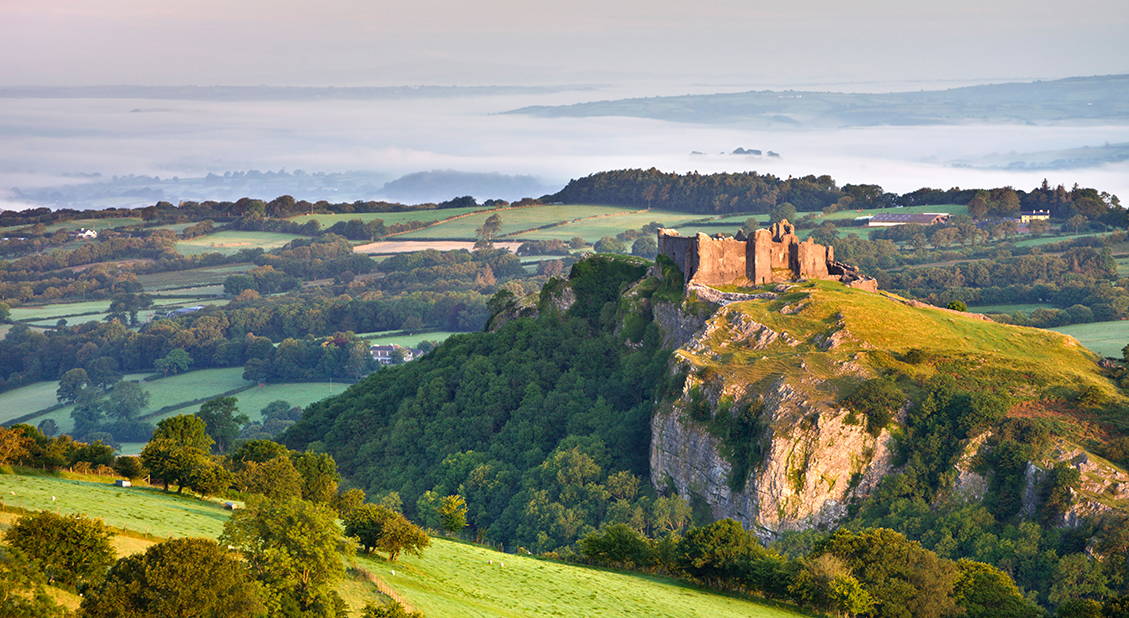A journey through the heart of Celtic Wales
Mark Rowe travels through the heart of Celtic Wales to meet some of the people keeping local traditions alive
Words by Mark Rowe
It feels as though I’m standing on top of a supertanker hewn from ancient rock. Far below, the flatlands of the Tywi Valley fan out around the serpentine, eponymous river. My berth is Garn Goch, the larger of two conjoined Iron Age hillforts atop an escarpment to the southeast of Llandeilo. Ravens croak, twittering skylarks lurch upwards, red kites tilt their fiery tails this way and that.
Clumps of boulders, massing five metres in height, lend Garn Goch a staggering stature. Underneath these Iron Age remnants, Garn Goch is believed to go back deep into prehistoric times. I’m exploring the fort with Chris Smith, who offers guided pilgrimage walks. Before we start, she hands me a piece of local quartz, a talisman she says. Later, she gives a blessing and reads a poem, Remembrance by the 20th-century Welsh giant of poetry, WaldoWilliams. It contains the lines: ‘One gentle moment as the night falls fast/ To bring to mind the things that are forgotten.’
“The Welsh landscape really lends itself to poetry, music and stories,” says Chris.
A pilgrimage, she explains, need not be religious: it can be spiritual, or a feeling of connection with nature, a sensation that can be particularly powerful in the landscapes of this quarter of Wales, where Ceredigion, Carmarthenshire and Pembrokeshire rub shoulders.
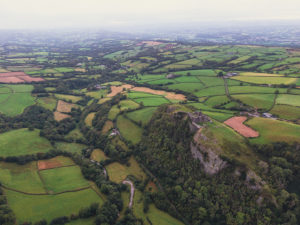
“I see it as getting people back in touch with the land,” she adds. I learn of two Welsh words with no direct equivalent in English: ‘hiraeth’, a sense of belonging; and ‘cynefin’, whose origins lie in a farming term used to describe the habitual tracks and trails worn by animals into hillsides. The latter has morphed and deepened to conjure a personal sense of place and familiarity.
For the outsider, the way this sense of place and deep time interweaves with rich history and legends adds up to a fascinating break. Later, we explore the castle of Carreg Cennen, which was probably built by Edward I’s baron John Giffard, who had a hand in the death of Prince Llywelyn ap Gruffudd, the last native Prince of Wales.
In contrast to the pancake flat Twyi Valley, the lumpy, bumpy landscape is as crenulated as the castle’s surviving ramparts: I’d defy anyone to find a square metre of farmland here where you could place a marble and not see it roll down a hill.
The sense that the castle has grown out of the rock almost becomes plausible as you slither down a vaulted passageway to a cave where the fortifications give way to protuberant stone.
For centuries, Llandeilo enjoyed high status as the county town of Carmarthenshire and an exploration of its narrow streets is a good way to see how long-standing cultural pride permeates through to the modern era.
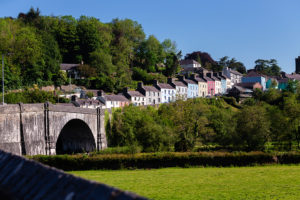
Particoloured Georgian townhouses, sturdy civic centres, are interspersed with half-timbered frontages, leering gargoyles, and independent shops selling antiques, local designer goods and speciality breads.
One trade is older than most. Gold has been mined in Wales since prehistoric times and pre-Christian Celtic chieftains both wore gold torcs and armbands of exquisite workmanship and grew wealthy as a result of trading it and other metals. Romans, then the Welsh princes, were equally bewitched. Curious to know more, I travel to Tregaron in Ceredigion to visit Rhiannon Evans, a jeweller who makes deeply ancient designs from Welsh gold. “This is our own culture” she says in her workshop.
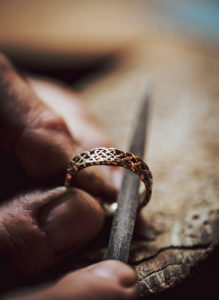
Celtic-inspired jewellery from Welsh gold. Credit: Thomas Brown photography
“Celtic art doesn’t really get the respect it should but it’s on a level with that of ancient Egypt or Greece. Much of it is not just Welsh, it is older, truly that of ancient Britain. I feel very lucky to be part of that tradition.”
Rhiannon’s jewellery (rhiannon.co.uk) draws on beliefs, folktales and oral traditions, of Celtic Wales, many from The Mabinogion, the 13th-century compendium of chwedlau, or prose folklore tales. Every design conveys a legend: white stags with red antlers for a creature that bestrode this world and the next; ancient triskeles reflecting the circle of life. A brooch combining a heart, the sea and waves recalls the tale of Seithennyn, a negligent princeling charged with preventing dykes overflowing but who drowned because he was more interested in earthly debauchery.
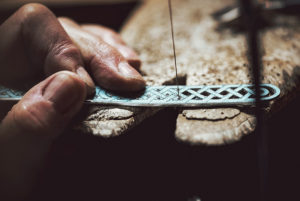
On request, Rhiannon makes pieces of jewellery on the full moon, as tradition associated this with healing. A small display upstairs houses a personal collection of exquisite ceramic figurines, ornaments and birds, their blues and reds surviving from prehistory.
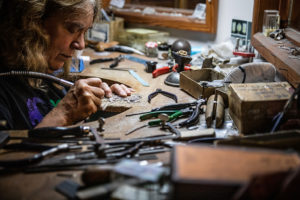
Another family-run business earthed in the landscape is the woollen mill of Melin Tregwynt, located just south of Fishguard in Pembrokeshire. I find the mill, in the Griffiths’ family since its inception in 1912, after weaving down a series of narrow lanes banked with solid Welsh turf and stone.
Visitors can walk around the warping shed and watch staff at work as they monitor the everthrobbing looms. The original watermill, now restored, is occasionally cranked into life.
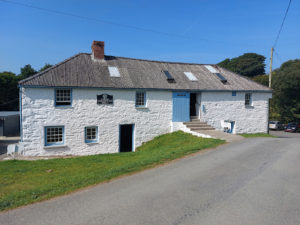
Set beside a small, fierce stream, the settlement of low-slung buildings, made from a distinctive purple stone, looks as it must have done when it began work.
“If mum and dad came back, they would recognise the machinery,” says Melin’s owner Eifion Griffiths,
“This mill still has a regular, beating heart.” Melin Tregwynt (melintregwynt.co.uk) has progressed from tweed dresses in the 1950s to stylish swish coats, throws and blankets and is now starting a project to use Welsh wool once more for its fabrics. The shop is crammed with unique cushions, throws, fabrics, lampshades, many threaded with double cloth patterns that stand in subtle contrast to the metronomic pounding of the looms. St David’s cross motifs are common, as is a design labelled ‘ysbryd’ (Welsh for ‘spirit’) that features squares, rectangles and shaded lines.
Having begun my exploration of Celtic Wales with a pilgrim walk, I end with a visit to a long-standing site of pilgrimage, the ruined abbey of Strata Florida, north of Llandovery. The landscape of this once great Cistercian monastery has been of immense spiritual importance to the Welsh people for a thousand years. The Latin name translates as ‘Vale of Flowers’, or ‘Ystrad Fflur’ in Welsh and the setting is bucolic, delineated by the ridges of the Cambrian mountains and the banks of the River Teifi.
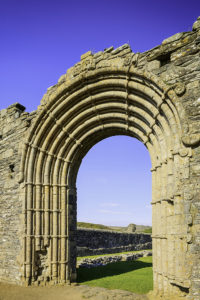
What little remains of the monastic precinct centres upon the magnificent Western doorway, where Celtic scrolls decorate a Norman arch, and which is aligned with the sunset on 1 March – St David’s Day. The abbey was funded by the wealth of the Lord Rhys ap Gruffudd whose kingdom of Deheubarth extended to the south- west liminal edges of Wales. Graves, horizontal raised slabs of 11 princes, are laid out to the rear of the abbey.
In the adjacent St Mary’s church graveyard, a solitary grave is etched with the image of a leg, marking the burial spot of the left leg and part of the thigh of Henry Hughes Cooper. Apparently, Henry lost the limb in an accident in 1756 and had it interred, intending to one day be united.
Instead, he died abroad and will forever remain separated from his leg. Nowadays there is a low-key but growing trend for Welsh people, from home and overseas, to visit Strata Florida before they die.
An adjacent 17th-century farmhouse and outbuildings are in the process of being restored. The former Tyˆ Pair (cauldron house) and cowshed already houses a small but engaging museum. The display includes some children’s tiny, leather shoes, which would have been stuffed up the chimney of the vast fireplace to confuse evil spirits.
Despite being utterly unsuperstitious, I’m struck by the strains of belief systems that to this day tie together these Celtic landscapes and the people who still live in them.
A week after returning home I find Chris’s quartz talisman in my jacket. It’s still there.
This is an extract, read the full feature in our June/July 2023 issue of Discover Britain, available to buy here.
Read more:
The Garrison Chapel and the Prince’s Foundation: The King and us
South West 660: The new coastal route for South West England

